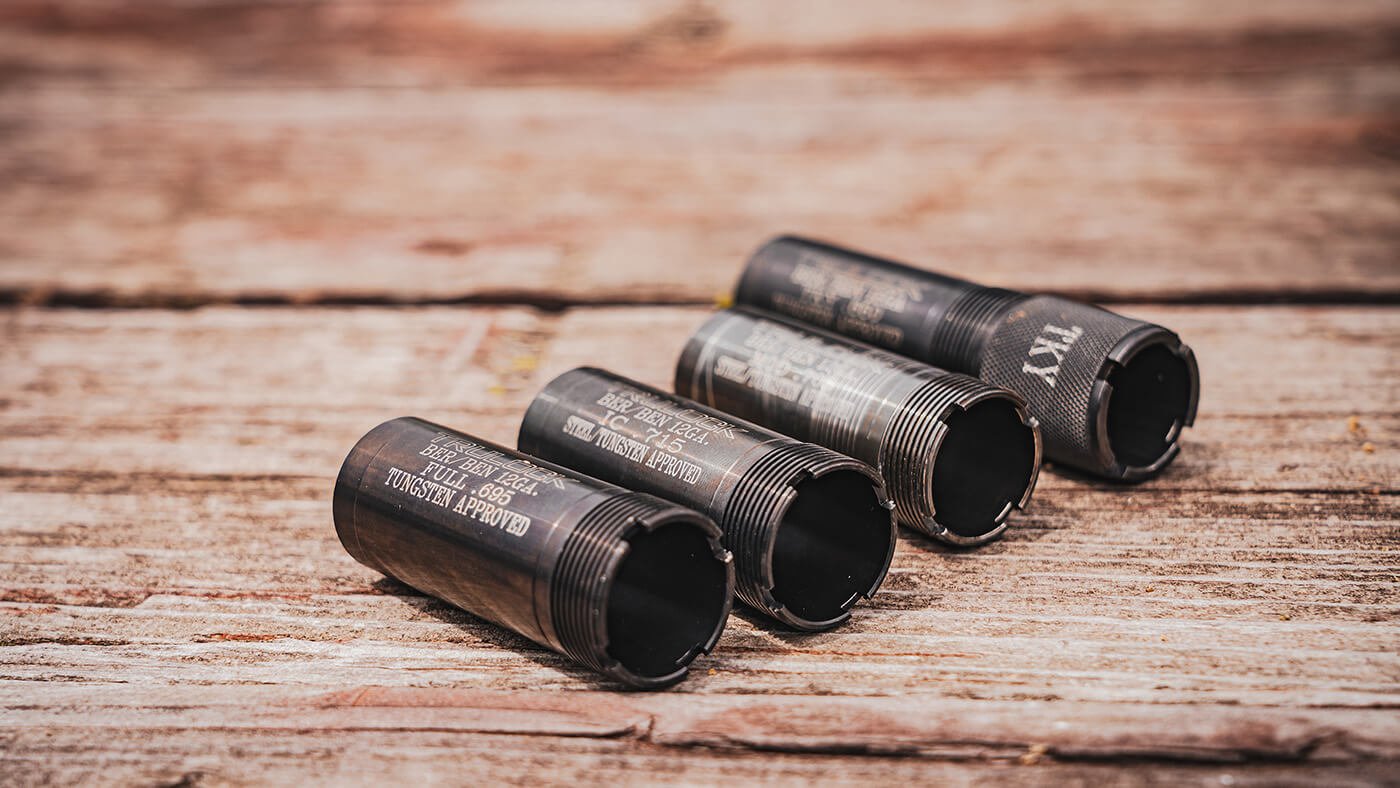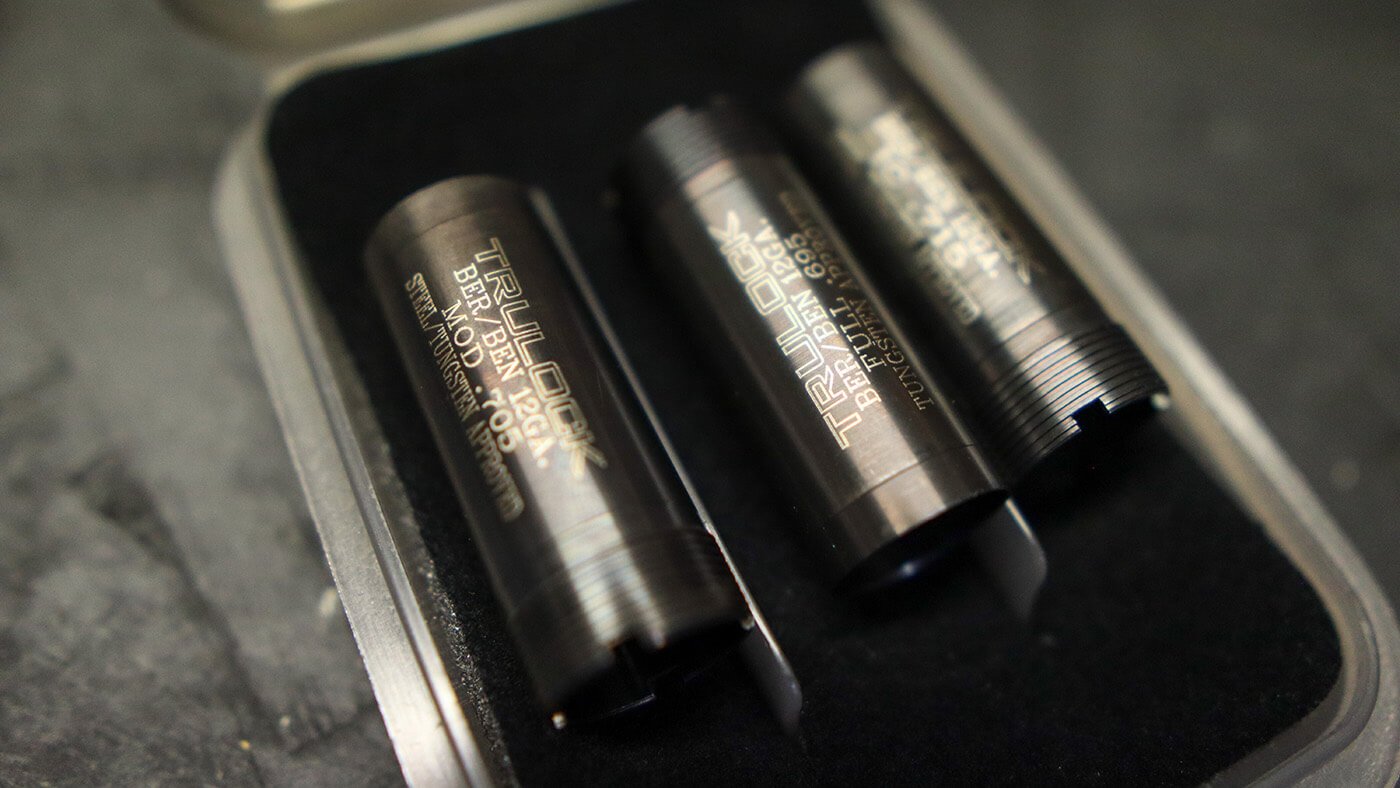- Savage Blog
- Choke Tubes: A Beginner's Guide
Choke Tubes: A Beginner's Guide

You can have the best shotgun in the world, but if you're shooting the wrong type of choke, accuracy will be a problem. Here's the A-Z on shotgun choke tubes.
It was challenging to watch, but it happens all the time. The new shotgun owner had purchased a racy semi-auto decked out with the latest and greatest. The problem: The shotgun didn't come with a choke tube set, and he was now on the hunt for a custom waterfowl wrecker.
I could see the sweat bead on his brow as he read the ink on the back of several custom chokes. I heard the man, several times, mumble words like, "long-range over decoys, pass shooting, ducks on the edge of decoys, ducks over decoys." He was confused and overwhelmed.
After talking to the new gun owner for a bit, he clarified this was his first-ever shotgun purchase, and this season would mark his maiden voyage to the woods and water. Love it. He was embarrassed to tell me he'd completed a shotgun training course and had no idea what a choke tube was. I patted him on the back, told him I was there once myself, and explained when I first started toting a shotgun afield, most models had fixed choke tubes. When interchangeable tubes came about, choices were still few and far between. Shotgun goers could choose between Modified, Full, and if the manufacturer was really on top of its game, Improved Cylinder. Today, shotgun makers create several tubes that typically come with the shotgun, and still, there are multitudes of custom choke makers on the market that take choke-building to levels few ever thought possible.
Then, right there in the sporting goods aisle, I took my new duck hunting friend to choke school.
What is a Choke?
Choke tubes control the dispersion of shot inside the shotshell. Without a choke tube added to the barrel's end, there would be no way to control the barrel's payload. The payload is the shot coming down the barrel, and that shot is concealed in a wad. If your shotgun barrel is threaded for chokes, don't ever fire the shotgun without placing a choke tube in the barrel.
As noted earlier, old-school shotguns featured fixed chokes, meaning you could not change them. If a gun featured a modified choke, that was the only choke option for the shooter.
Today's shotgun barrels have threaded ends, which accept various choke tube designs to give the shooter maximum control of shot dispersion to match the shooting or hunting situation. You should never fire a shot from your shotgun without a choke tube in place. Doing so could result in serious damage to the barrel, the barrel threads, and you won’t get a uniformed pattern.

What is Constriction?
Think of a boa constrictor snake. These snakes kill prey by wrapping themselves around the animal and squeezing it to death. That's the best way I know to describe constriction. How the choke tube is built will dictate the amount of constriction it places on the shot — how much that tube squeezes down on the shot pattern. The tighter the choke — the more the constriction it puts on the shot — the tighter the pattern and punch at further distances. On the flip side of the coin, a choke tube built for less constriction allows the shot to separate quicker in a uniformed pattern as it exits the barrel and travels downrange.

Choke Tube Configurations
If you read nothing else in this article, please give this section a thorough once-over. If you're unsure about choke tubes or their purpose, this section will make it crystal clear.
There are many different choke tubes, but Full, Improved Cylinder, and Modified are the most common. These will be the three you need to know.
A Full choke has tight shot constriction. The choke choke's down the shotshell's pellets and keeps the payload tight and together to ensure downrange lethality.
Improved Cylinder chokes feature slight constriction. If your shotgun comes with three chokes, this one will create the most extensive patterns. The idea behind this choke build is to control the pellets but allow those pellets to spread to cover a beach-ball-like diameter at distances of 20 and 30 yards.
Modified means moderate. The Modified choke is the most commonly used choke tube, and this is because its design serves a variety of purposes. Constriction is less than a full choke but more than an Improved Cylinder Choke. The Modified choke keeps pellets together semi-tightly, allowing them to expand, but not to patterns as large as the Improved Cylinder choke.

Ammunition and Chokes
When the non-toxic shot era began, most shotgunners had to purchase new guns. Why? The fixed and even interchangeable choke options wouldn't handle steel shot. Almost every shotgun maker worth their salt has remedied this problem. Modern-day choke materials typically allow the use of lead, steel, bismuth, and tungsten. However, some chokes don't, and you'll need to ask these questions before making your shotgun purchase. I also encourage you to examine each choke tube after purchase. If the choke is limited to steel only or lead only, that information will be indicated on the tube. Contact the manufacturer or give your owner's manual another glance if you're unsure.
Also, just because a tube will handle a particular shot material, it may handle another material much better. This is why patterning is essential. More to come on this.

Patterning and Distance
Now we get to the pattern portion of the article. You will never know how your Full, Modified, or Improved Cylinder handles different types of shot material unless you pattern that choke with the shot material you plan to use.
For instance, I have a came-with-the-gun Full choke that puts 60-plus pellets in a turkey targets head at 55 yards when the choke is constricting Tungsten Super Shot. Take that same choke and low-grade lead, and the pattern gets more expansive, and the number of pellets in the head and neck area shrinks.
No matter what choke you're shooting, it would help if you patterned that choke with the exact shotshell you plan to hunt with to understand the range and pattern the choke is effective. For instance, if you plan to shoot an Improved Cylinder for doves (great choice), check your patterns at distances of 20, 30, and 40 yards. Nothing will help you learn more about choke tubes like testing and tinkering with them.
Best Chokes for Hunting
When paired with today's quality shotshells, especially those loaded with bismuth, tungsten, or a mixture of either metal and high-quality steel, you can harvest large birds like turkeys and geese at distances up to 60 yards. Yes, there are multiple reports of hunters killing game at further distances, and two seasons back, I toppled a strutting tom at 71 yards with Federal's TSS and a custom X-Full choke, but that was with a red-dot sight and lots and lots of patterning practice.
A full choke is my go-to choke when hunting turkey. Keep in mind that when using a full choke to jelly the head of a tom, you don't want the shot to be too close. You may miss a too-close tom due to nerves and the small diameter of the pattern at close range. Perfect turkey range for a full choke paired with a quality shot is between 30 and 40 yards.

When pass-shooting geese and ducks or hunting these birds late in the season when they get stubborn about landing in the decoys and prefer to tease the spread's edge, I once again go with the full choke. I want long-range killing power and a concentration of pellets in a tight pattern at distances of 50 yards and beyond.
Ducks and geese over decoys, however, is a different story. I prefer a Modified choke when quackers and honkers let the air in the decoy spread. Some will go with an Improved Cylinder, and if the quarry is teal or small puddle ducks, I will as well, but when hunting Canada geese, snows, and large puddle ducks like mallards, I want a moderate pattern that's not too big and not too small. Plus, as if you plan to harvest multiple ducks — doubles and triples — you want a choke tube with killing power at distances beyond 40 yards. A Modified choke gives me room for error and holds a tight enough diameter between 20 and 40 yards to crumble large birds, and I can pull birds beyond 40 if I'm using the a quality shotshell and am on my game.

If doves, quail, trap, and skeet are on the menu, I'm an Improved Cylinder fan. Fast-flying doves and flushing quail present a real shooting challenge, and I'll take all the pattern help I can get. Both birds are small, which means lesser-sized lead shots like #7 1/2 and #8 can be used. Small shot paired with a great pattern means lots of pellets in the air, and a big area around the target is being covered due to less choke constriction. I use the same mentality when busting clays on a skeet, trap, or sporting clay course.

Larger upland birds like pheasant, chucker, and grouse require a more prominent shot size. My all-around go-to when shooting standard lead is #6 shot. If I'm slinging bismuth or tungsten, I like #7 1/2. Early in the season, especially when hunting grouse, I want an Improved Cylinder. These birds are not the brightest creatures ever to fly and typically hold tight and create close-range shots when flushed. Even early in the season, pheasants and chucker can flush at a distance, so I prefer a Modified choke. Late in the season, unless there is a lot of snow to hold the birds and dogs are being used, I switch to a full choke and go with a more prominent shot size when chasing upland birds.
Do yourself a favor. If you're hunting within what state game and fish laws say is too-close to water for lead shot use on upland birds, go with bismuth or tungsten, or blend one of the two materials with top-quality steel. I like a Modified choke for upland pursuits near water. Lesser-sized steel shot doesn't get the job done.

If you want to hunt deer with your shotgun, you'll need to use a slug. Read the manufacturer's recommendations thoroughly if you're planning to use a choke that came with your shotgun for slug use. Typically, the least restrictive choke will be the best for shooting slugs, which means the Improved Cylinder choke. Chokes with more constriction than an Improved Cylinder can create serious safety issues.
Buying Custom Choke Tubes
I'm a custom-choke tube nut. While today's shotgun manufacturers do a remarkable job of choke build, custom chokes can enhance effective range, pattern density, etc.
There are multitudes of custom choke manufacturers on the market, and the quickest way to see if a specific choke maker creates a choke designed for your shotgun is to visit the website of the custom choke builder and start looking.

For example, let's say you have a Savage Renegauge Waterfowl you purchased to be your new bill wrecker. The gun comes with a Full, Improved Cylinder and Modified (Beretta/Benelli Mobil) choke. Still, possibly you want an extended port choke tube, and you're kicking around a Carlson's Bismuth Bone Buster. The process is simple: Visit Carlson's website, locate the Beretta/Benelli Mobil Bismuth Bone Buster, and you're set to go.
There you have it, the choke tube 411. When choosing choke tubes, the biggest thing to remember is understanding what each specific choke was created to do. Once you know the purpose of the choke, test it by patterning it on paper with different shotshells loaded with various types of shot material to prove to yourself the tube is performing as advertised.


